This website uses cookies so that we can provide you with the best user experience possible. Cookie information is stored in your browser and performs functions such as recognising you when you return to our website and helping our team to understand which sections of the website you find most interesting and useful.
Villa Bogdano 1880: old vines, new ideas
Villa Bogdano 1880’s historic vines, high biodiversity and premium wines make the estate one of the leading lights in the Veneto.
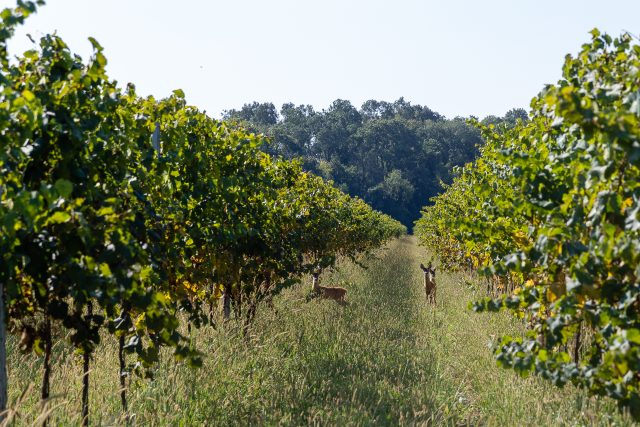
“We chose to take care of this place, to become its respectful and silent custodians. When we arrived here in 2016, the property was going to be purchased and turned into an intensively farmed monoculture vineyard. This would have meant losing the origins of a historic, rare and unique winemaking heritage.” – founder Domenico Veronese
VILLA BOGDANO 1880
Present day Villa Bogdano 1880 is working on the integrated and sustainable development of wine, history and nature. The wines’ origins are in Lison di Portogruaro, near Venice, between the Alps and the Adriatic coast, within the Planitia Estate, which includes a lowlands wood dating back to 1200 and is classified as a Site of Community Importance for its preservation of biodiversity. Every choice is made specifically to be in harmony with nature, such as the organic certification in 1993 and the promotion of native varieties. Villa Bogdano 1880 is an environmental paradise for its wines and a guarantee for the health of the consumers who choose them.
Villa Bogdano 1880 in numbers
- 1993: organic certification was awarded
- 2016:current owners purchase the estate
- 185 total hectares (12 woodland ha, including ancient lowlands woods dating back to 1200) 106ha of
vineyards (18 historic ha) - Four historic buildings dating back to 1500-1600, two archeological sites from the Roman era, certified but still to
be unearthed - Fewer than 30,000 bottles produced each year
NATURE
The vines grow at the edge of a lowlands wood dating back to 1200. The choice of the Latin word Planitia for the estate’s name was made by the current owners as they wanted to pay tribute to a place that hosts one of the few lowland forests left in Italy, dating back to the Middle Ages, protected by the Ministry of Culture and classified as a Site of Community Importance by the European Union for its varieties of florae and faunae.
The estate is home to many animals. Roe deer can be seen at the edge of the plantations, owls and harriers keep watch over the vineyards, searching for the voles and moles that inhabit the uncontaminated rows of vines. The area is also a stop-over for many species of birds during migration, overwinter and nesting such as European green woodpeckers and grey herons. This oasis is also a refuge for other vulnerable species such as yellow-bellied toads, Lataste’s frogs, northern crested newts, European pond turtles and stag beetles. One of the projects in its initial phase is a collaboration with a Naturalist Observatory to reintroduce various endangered species and extend the area allocated to the overwintering and repopulation of some bird species.
HISTORY
Together with nature, a glorious past the estate’s history is tied to that of the Roman Empire. The first human settlements within the current borders of the estate date back to the first century BC, where Via Annia, an ancient consular road, connected the cities of Padua and Aquileia. Under the Republic of Venice these territories enjoyed new splendor. At the end of the 16th century, with the institution of the Provveditorato ai Beni Inculti, or body of local governors, the land was assigned to noble Venetian families, including the Giustians. It was they who designated the land for farming and carried out irrigation works, as well as constructing numerous buildings including a noble house (the current Villa Bogdano), a convent and rural houses.
In 1880, Villa Bogdano was refurbished and the main farming activity became wine-growing and producing. As precious testimony in Italy, today 117 of the vines once cultivated with Cassone Padovano, an ancient vine-training system used by Benedictine monks, are still standing. They have been meticulously restored and are still in production to this day.
TERROIR
The estate has not undergone any reclamation procedures, therefore the soil has maintained its original characteristics and avoided receiving lower quality fill. The surface of this typical alluvial soil, which is rich in calcareous substances, minerals and micro-elements, is covered in a thick layer of clay (with average levels that reach 54%) and is as hard to work and unforgiving in its yields as it is satisfying in its production of wines with a significantly intense taste and aroma, great elegance and finesse (it lends a refined softness to the tannins).
THE VINEYARDS
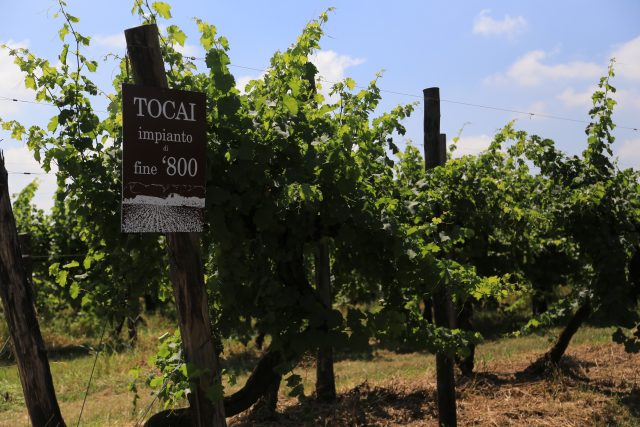
There are 106 ha of vineyards, of which about 18 are historic, some are over 100 years old and have been meticulously preserved. Starting, in particular, with the antique Cassone Padovano system (an early form of vine-training used by Benedict monks and now almost completely abandoned), the company began replanting a clone of the Tocai Friulano variety, starting with the buds of the mother plant to maintain its original genetic characteristics. Furthermore, the concrete posts were changed for ones in acacia, debarked naturally without the use of burning or chemical treatments.
The estate is surrounded by two rivers: the Lison and Loncon. This creates a barrier of protection from possible contamination from chemical plant protection products used in confining land. The immediate vicinity of the vineyards to the winery significantly shortens grape processing times, starting from the moment of harvest, reducing greatly the need for sulfites. Promotion of native varieties is a priority: as well as Tocai Friulano and Glera, there are Refosco dal Peduncolo Rosso vineyards and Malvasia has been replanted. Various international varieties which adapt well to the territory, such as Merlot and Pinot Grigio, complete the range.
Vine-training method: high-density Sylvoz.
THE WINES
All the wines are produced and bottled in the wine cellars with organically grown grapes, certified by the ICEA consortium and produced exclusively in house. Grape harvesting from all the historic and some of the modern vineyards carried out by hand, limited use of plant protection products, only organic composts, only mechanical weed control and the application of cutting-edge technical equipment allow the environment and delicate Lowlands Wood, an integral part of the estate, to be conserved and preserved.
In the cellars, alongside the French oak vats and barrels (large dimensions are favoured, up to 45 hectoliters), ample space is given to the barrels in vitrified concrete, which combine the high thermal stability of concrete to the neutrality and pureness of the vitrification. The aim is to give as much value as possible to the characteristics of the varieties and terroir. Particular merit goes to Refosco dal Peduncolo Rosso, a little-known native variety which requires a heroic effort to harvest at the just right moment of maturation in order to tame its herbaceous, harsh and wild tannins. Low yields, great effort and hard work in the vineyard recompense the palate when the wines are tasted.
The identity of the wines has its origins in a unique terrain, the knowing hands of skillful oenologists and expert consultants, and the choices made in the vineyard and cellar combined with careful attention and innovative equipment.
The products most representative of the Villa Bogdano 1880 are:
LISON CLASSICO DOCG
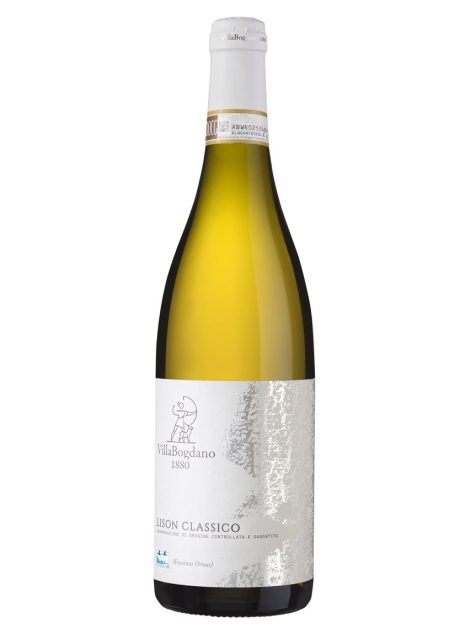
This wine is the symbol of the company’s winemaking and was the first DOCG. Obtained from Tai grapevines planted in 1943, during vinification this wine undergoes cryo-maceration of the grape skins.
A pale-yellow colour with golden highlights. An intense and complex aroma, with floral and fruity notes. On the palate it is fresh, flavourful and balanced by its smoothness.
Label: reproduction in laminated silver of the bark of ‘Fraxinus Omus’, which is present in the lowlands wood.
REFOSCO DAL PEDUNCOLO ROSSO DOC LISON PRAMAGGIORE
Refosco del Peduncolo Rosso is a native Venetian wine variety. Its particular name derives from the red colour of the peduncle, the part of the stem (stalk) near the grape. Villa Bogdano 1880’s interpretation of this wine comes from the maturation on fine lees for eight months – in part in concrete vats, in part in wooden barrels with periods of bâtonnage – and then aged for three months in the bottle.
In the glass, the colour is a deep ruby red, with an intensely floral aroma and is characterised by its vegetal and spicy notes. Also available in the Reserve version, aged 30 months.
Label: reproduction in laminated bronze of the bark of a ‘Carpinus Betullus’, which is present in the lowlands wood.
195 ROSSO VENETO IGT
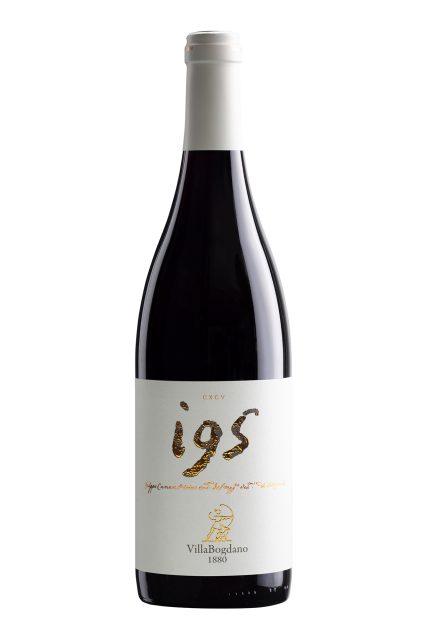
Rosso 195 is the special blend produced with 85% Merlot grapes and 15% Cabernet Sauvignon. In accordance with an antique Venetian tradition, it is bottled on Good Friday, which for the 2017 harvest fell on 10 April 2020, after having spent 12 months in concrete vats and 18 months in French oak barrels and barriques.
In the glass the colour is ruby red with a garnet tinge, the aroma is intense with notes of blackberry and plum, and it is full on the palate with a long finish.
The label depicts the land on which the wine was grown, both in tribute to an antique Venetian map from 1676 portraying the estate, as well as a way of showing our commitment to producing wines only with our own grapes from selected plots.
PINOT GRIGIO RAMATO DOC VENEZIA
Copper-hued Pinot Grigio Ramato has an ancient tradition in the Republic of Venice. It comes from a specific way of winemaking: the must is left in contact with the grape skins and enriches the wine with a pinkish shade. It’s among the newer entries in the Villa Bogdano 1880 range and was bottled for the first time in spring 2021.
PROSECCO ROSÈ DOC
A characteristic of the Villa Bogdano 1880 Proseccos are their velvety, soft and delicate bubbles and long finish on the palate. The abundance of polyphenolic extracts and compounds allows residual sugar levels to remain low as a soft component. These characteristics are also shared by the rosé version of Prosecco, produced with a selection of Glera (90%) and Pinot Nero (10%).
SUSTAINABILITY
For Bogdano 1880, the definition of natural estate is not limited to the land but encompasses all the company’s choices. As well as choosing to use only organic fertilisers, reduce the use of plant protection chemicals, and ensure the correct maintenance of the grass lawns and a correct management of internal waters in order to guarantee biodiversity, it was decided to use FSC certified packaging and reach energy independence through solar power over the coming years.
THE PEOPLE
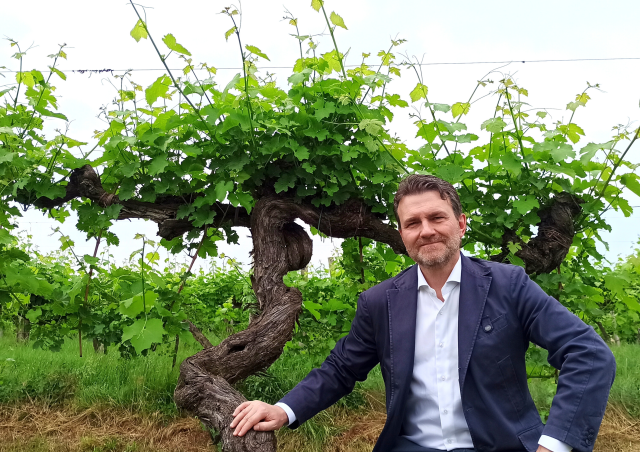
At the helm of Villa Bogdano today are Domenico Veronese and the CEO, Lucio Tessari, alongside a team of people who share decades of friendship and trust. The company was bought in 2016 after being in the hands of a Lombardian family for three generations as Tenuta Agricola di Lison. Domenico and Lucio arrived here from two very different professional backgrounds which had one objective in common: bring the estate back to its original splendour, promote the winemaking, artistic and environmental heritage and protect the area’s nature.
Domenico Veronese – co-founder
After gaining his diploma from a classical high school in Portogruaro, he graduated with honours in Business Administration from Bocconi University. He previously held positions of responsibility at leading international investment banks and investment funds, mostly in the UK, and divides his professional and personal time between the UK, Italy and Germany. He is married and lives with his wife and daughter in London.
Lucio Tessari – co-founder and oenologist
Born in 1968, he’s the same age as his founding partner, Veronese. He holds a diploma in enology from the G.B. Cerletti School of Enology in Conegliano Veneto, Treviso, Italy and worked first at Coldiretti and subsequently at Più Servizi, a company offering consulting in winemaking, of which he was partner. Before founding the Planitia Estate, he made wines for almost 20 years for prominent companies in the Italian wine-sector.
THE LOGO
History also plays a leading role in the Villa Bogdano 1880 logo, which is inspired by the figure of the Goddess Diana. Lison’s Roman roots emerged in the 1920s when various artefacts from the Roman era came to light following excavations. The most important find was a bronze statue of Diana, goddess of the hunt, which has a deer and dog at the base and is today preserved at the Roman museum in Portogruaro.
To discover more, click here.


